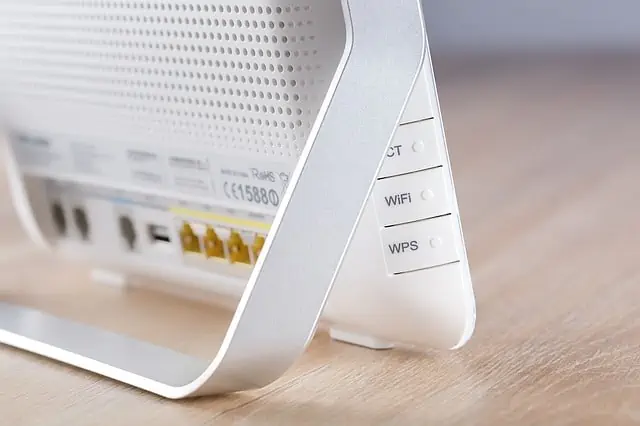This is a common issue in home networking, where users want to know the difference between the different types of reboot/restarts/resets, to make sure they don’t lose any data or settings when they don’t want to.
In this guide, we’ll fully distinguish between quick/soft resets, power cycles and full factory resets on a router, detailing how to do each one, and what they do and don’t do.
Here is a summary answer:
A reboot/reset on a router involves pressing a reset or power button to quickly restart it, whereas a power cycle involves fully unplugging a router for at least 30 seconds before restarting. Neither of these should delete any settings, but a factory reset involves pressing a reset hole for 20-30 seconds, and will restore all router settings to default.
We are aware that the main concern for home internet users on this topic is making sure they don’t delete any custom settings or data, so we’ll make sure we fully compare and contrast all the different types of reboots/resets, plus how to avoid the “nuclear” option of a factory reset if this is not what you want to do.
What Is A Reboot/Quick Reset?
Let’s start off with the simplest case -a quick reboot or reset, also sometimes known as a “soft” reset.
This is when you simply press a reset or power button on a router quickly to restart it.
Something, like this:
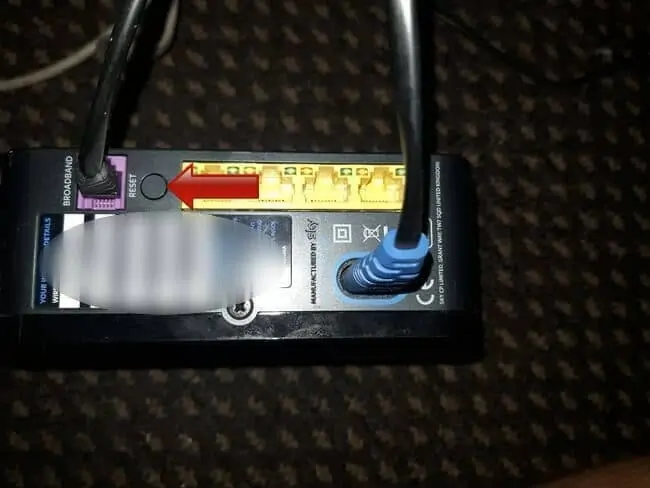
Or some common variant on this:
- There might be a Power button that you press quickly to reboot.
- There might be a Power toggle/switch you can turn Off/On.
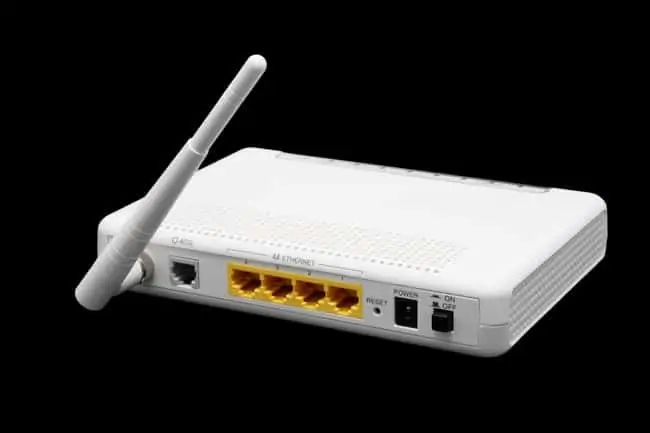
It will be set up differently on different routers, but whatever the setup of your model, I would classify a quick/soft reboot/restart/reset as one of the following:
- Quickly pressing a protruding reset or power button (not a recessed reset hole)
- Toggling the router Off then On again quickly using a power switch/button, but still leaving it plugged in.
This should perform a simple reboot/restart of the router, which does the following:
- All devices remain connected to the router. Most times, you won’t even need to re-enter the password (occasionally, some devices might have to)
- The Wi-Fi username(s) and password(s) all remain the same.
- Router login credentials should remain the same (either the default ones on the back or custom ones if you’ve changed them manually)
- All router settings remain the same
- There will be a disruption of connectivity (usually for around 1-2 minutes) while the router reboots. This does mean that online streams/Skypes will be interrupted.
- Downloads may be cancelled and have to be restarted. Sometimes they can be resumed from where you left off, but not always.
What Is a Power Cycle?
Now let’s turn to the closely related concept of a power cycle. It can sometimes be that a router doesn’t even have a power On/Off switch on it, especially for older models. Or you want to do a more thorough version of a quick reset, but still not lose any data.
In this case, you are best off going for a power cycle option, where you fully unplug the device from the power socket for at least 30 seconds, and then plug back in and restart.
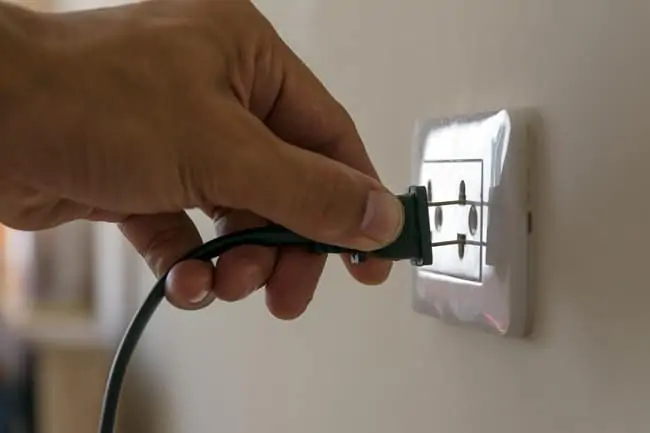
This should flush out any residual power/current from the router, and acts as more complete version of a quick/”soft” reboot, but still doesn’t classify as a factory reset. You might need to give your router 1-2 minutes to come back online once you restart it though. Devices may or may not need to re-enter the Wi-Fi password to reconnect, depending on how long it’s been off.
A power cycle can be a good way of refreshing the connection if you are having problems and a quick reboot didn’t seem to fix it. Unplugging your router for a short time can also be useful in letting it cool down, since overheating can also affect performance.
Are a Reboot/Reset & Power Cycle Equivalent?
This is a complicated question, made especially more so by the fact that different terms are sometimes used by different people.
However, here is a summary answer:
To be fully sure you have completed a legitimate power cycle, it probably is best to fully unplug the device from the wall for at least 30 seconds. This differentiates it from a quick reboot/reset, where you are pushing a button or flicking a switch to quickly restart it, but leaving it plugged in.
In this sense, it could be argued that a power cycle is distinct from a quick reboot/reset/restart, where you are just pushing a button to quickly restart a device, but power still continuously flows through it. I would argue that quickly turning the router off from the wall and then turning back on without unplugging is somewhere between a quick reboot and a power cycle. Other would still call this a power cycle.
Some people might argue that toggling off/on a power switch on a router – what I classed as a “quick/soft” reset above – is a form of a power cycle. I would say you need to unplug something to do a full power cycle.
However, in terms of the outcome with routers, you get the same result whether you do a quick reboot or a power cycle – the device restarts but you don’t lose any data or settings.
In this sense, for routers at least, the distinctions between a quick/soft reset and a power cycle aren’t all that important. If you want to be more thorough about it, go for the power cycle option, but the result should be the same.
What Is a Factory Reset?
Now let’s go to the most extreme form of reset on a router – a full factory/default reset. This is more clear cut.
On most routers, there’s simple reset button somewhere prominent, and also a reset/factory reset hole somewhere else. This is pretty clear. Quickly pressing the reset button quickly resets the router (quick/soft reset – does not wipe any settings). The reset hole is what you push a pin into for up to 20-30 seconds for the full reset until the lights on the front blink or go out (will wipe all settings and restore router to default).
It often looks something like this:
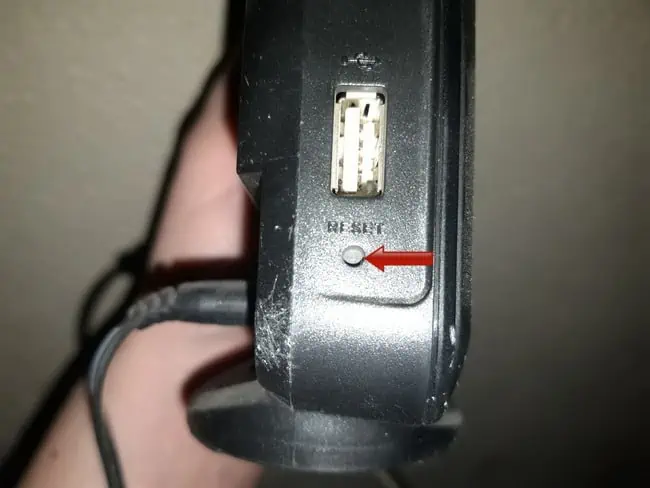
Pushing a bent safety clip or other sharp object into this hole for 5-30 seconds until something flashes/blinks is what does the factory reset.
This is a more extreme form of a reset; here’s what happens when you do a factory/default reset:
- All custom Wi-Fi SSIDs/usernames and passwords to access the network will be lost and reset to the defaults indicated on the sticker on the back of the router. So any users who need to reconnect will need to find the router again on the network list and re-enter the default password to use the Wi-Fi.
- If you have also set custom values for the router login admin/password (to change settings), these will also be reset back to the default values indicated on the sticker on the back.
- If any gamers have set a static IP for their console on the router, this will be deleted and they’ll have to do it again.
- Any other custom settings that were configured on the router (eg. QoS, DNS settings, DMZ) will be lost and need to be reconfigured.
- All logs and stored browsing history will be wiped off the router.
- Factory resets can sometimes also take longer than quick resets, with a disruption of connection for sometimes several minutes.
- See our article on hard resetting your router for more on this, plus how to get settings back to how they were if you need to.
Quick Reset vs Factory Reset For a Router
We’ve effectively already answered this, but we’ll summarize it briefly again here:
A quick or soft reset involves simply restarting the router using a power/reset button or switch, but keeping all the settings intact. A factory reset involves pushing something into a reset hole to fully restore the router to factory settings, as it was when it shipped new from the factory.
In other words, the quick or soft reset is the easy option just to refresh the connection but keep everything else the same. The factory reset is the more drastic ‘nuclear’ option that wipes any custom settings and data/logs and restores the router to how it was when it was brand new and first plugged in.
How To Avoid Doing a Factory Reset
A common crucial distinction in all this is that users simply want to know how to avoid factory resetting their routers to avoid losing any settings or details.
In simple terms it boils down to this:
To avoid factory resetting your router, stay away from any recessed reset holes on the device. Do not insert any sharp objects into it and instead either use the normal reset button/switch or the power supply to quickly reboot the router without wiping any settings.
In other words, avoid anything that looks like the red hole pictured above. Use reset buttons or switches or do a power cycle instead.
In fairness, it’s pretty much impossible to do a full factory reset on any router accidentally because of the way you need to initiate them. On most routers, you need to push a sharp object into a recessed “reset” hole somewhere for several seconds at least; on some routers up to 20 or 30 seconds, and then release when the lights on the router blink or go out.
I think it will be difficult to find someone who’s ever done this by accident! The process is designed to be intentional precisely to avoid it being done accidentally, so there isn’t much to worry about. However, on a very few routers, even just pushing something into this hole for as little as a few seconds can initiate a factory reset, so just to be safe, keep any sharp objects away from this hole to avoid any scares.
Whenever you’ve just flicked or pushed a reset button quickly by accident, it’s going to be the quick reset/reboot button, and barring some minor inconvenience as the router restarts, and some annoyance from disconnected users, there’s no need to worry about losing data or settings.
